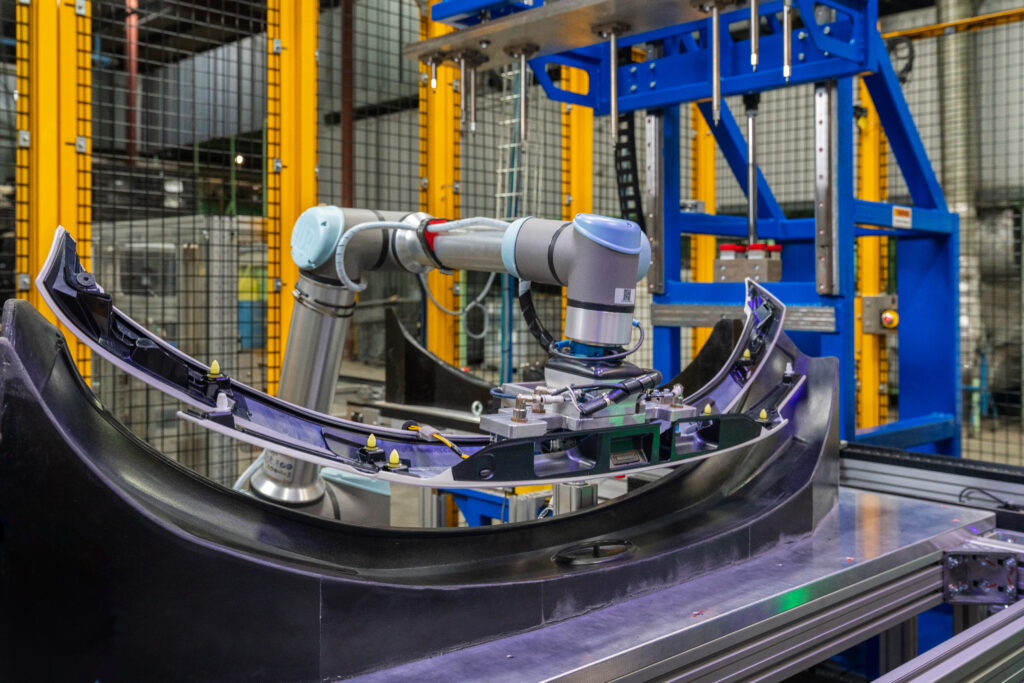A Fully Integrated Automation Line Becomes Reality at Chiyoda USA with Support from a Manufacturing Readiness Grant
Chiyoda USA
Case Study
Key Stats

Company History
Chiyoda USA is a Tier 1 supplier producing interior and exterior automotive trim for one of Indiana’s large OEMs.
Chiyoda USA Corporation is a Japanese-owned American company that started operations in Greencastle, Indiana, in May 2005. Its Greencastle campus is now home to three manufacturing buildings where 300+ employees produce automotive interior and exterior trim. A Tier 1 manufacturer with injection molding, blow molding, color-matched body paint and assembly capabilities, Chiyoda supplies plastic parts to automotive customers. Chiyoda has several customers, but more than 90% of its products are supplied to an Original Equipment Manufacturer (OEM) based in Indiana.
Kevin Redding, now President and COO, joined the company as Vice President of Manufacturing in 2018 at a time when the plants operated with minimal automation. As he grew into the role, he took several steps toward automating Chiyoda’s production lines by adding new systems and equipment, such as automated conveyors, software systems and other connected machines. But Kevin recognized early in their automation journey that these independent installations created “islands of automation” that were disconnected from each other. “They don’t yet communicate with other automated stations around the plant,” Kevin explained.



As Kevin and the Chiyoda leadership team thought about the future of manufacturing and how to continue their legacy as a high-tech, cost-effective supplier for their OEM customers, they knew the production process at Chiyoda needed enhancement. Kevin’s previous experience at a company where automation was fully integrated gave him invaluable insights to help scope out what talent, hardware and software would be needed.

The Project
The technology adoption project was “an evolutionary step” in automation for the Greencastle manufacturer.
While the technology project wasn’t necessarily driven by its customers, it was about solidifying Chiyoda’s competitive edge in the market. “It’s an exciting time for us,” Kevin said. “The technology adoption project will help stand up our first fully integrated production line at Chiyoda, and it’s one of the largest next to our paint lines. The automated production line will help us improve overall efficiency, quality, throughput, ergonomics and workforce safety by taking over high-volume and repetitive tasks,” he explained. Chiyoda can now adapt its workers from manual assembly tasks and upskill them to operate automated equipment, like the robots powering the automated production line.
The automated production line includes Universal Robot (UR) cobots and Yasakawa robots with integrated machine vision, safety devices, and AI for quality inspection.
“Our assemblies can be fairly complicated,” Kevin said. “We check for about 36 to 38 different points to ensure quality.” Kevin and the Chiyoda leadership team knew it would take Artificial Intelligence (AI) paired with machine vision systems to eliminate the manual steps in the quality inspection process. For example, machine vision systems check to see that a part is in the exact same place each time. “Basically, it’s learning where the components are, where they can be, where it’s acceptable for them to be and where it’s not acceptable for them to be,” Kevin explained. “Then it communicates back to our integrated software systems whether it’s a good part or a bad part.”

Another critical piece of the automation project was workplace safety. With new robotics operating in its facility, Chiyoda implemented “safety light curtains” to prevent accidental interactions with automated equipment. Kevin explained, “the safety light curtain is a device that is constantly scanning for potential inference, and it replaces a solid barrier around robotics and other equipment. It gives our workforce the capability to fix issues on the production line very quickly. If the robotics were surrounded by a physical barrier, it would be a different story.”
Manufacturing Readiness Grants (MRG) provided by the Indiana Economic Development Corporation and administered by Conexus Indiana are available to Indiana manufacturers willing to make capital investments to integrate smart technologies and processes that improve capacity and productivity. An MRG of $200,000 helped Chiyoda USA implement an automated production line to manufacture an automotive exterior trim component for one of its large OEM customers.

Key Learnings
Executing a technology adoption project requires systems thinking and the right talent.
“I don’t think technology adoption projects ever go as easily or as smoothly as you anticipate,” Kevin said, “and we certainly have learnings to take away from this project.” Chiyoda’s first step to ensure success was hiring a manufacturing systems engineer and then building out engineering talent that reports to this person. “You can’t just piecemeal an automated production line together,” Kevin said, “you must assign a project leader and provide them with the right resources.” Having an accountable project leader thinking about the system holistically gave Chiyoda the confidence to take its first steps in a new automation journey.
“We’ve sent our maintenance and production workers, not just our engineering group, to receive training from technology providers. Our desire is always to level up our associates to an automation or maintenance technician level. We brought an employee — a molding technician — from another department and trained him as our first automation technician. We’ve also hired two techs from outside,” Kevin recalled. Another important element to upskilling is not to have tunnel vision and look for an employee with a “checklist of skills.” Kevin says the Chiyoda team looks for employees who use systems thinking and anticipate problems. “A great trait of an automation technician is the capacity to problem solve and constantly anticipate what could go wrong. We continue to be in good hands thanks to our workforce.”
“The automated production line will help us improve overall efficiency, quality, throughput, ergonomics and workforce safety by taking over high-volume and repetitive tasks.”
Kevin Redding
President and COO at Chiyoda USA

